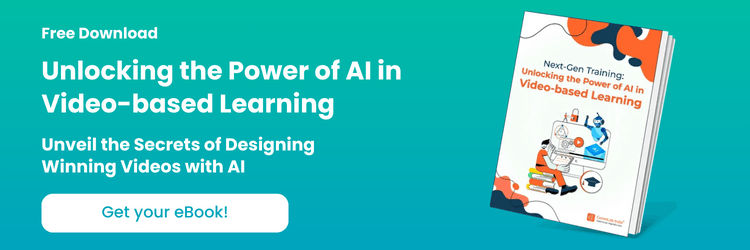In today’s world of training, training videos aren’t just a bonus — they’re a must-have. Whether you’re building microlearning courses, onboarding modules, or compliance training, video is one of the most effective formats to engage learners, reinforce concepts, and scale delivery.
According to the LinkedIn Workplace Learning Report 2024, 58% of L&D leaders are increasing their investment in online learning. Video-based training ranks as one of the top 3 most effective modalities for both knowledge transfer and learner engagement. And with the rise of hybrid and remote work, asynchronous video has become a must-have format for onboarding, compliance, and upskilling.
→ Download Now: Are You Ready to Charm Your Learners with the Magic of Videos?
But with so many video creation tools out there, how do you choose the right one — especially when speed, scalability, branding, and LMS compatibility all matter?
This detailed post compares three leading video production tools— Vyond Go, Synthesia, and Canva — specifically tailored for Learning and Development professionals looking for intuitive tools to create professional, on-brand videos that meet content scalability, cost-effectiveness, branding consistency, and LMS integration requirements, often without needing a dedicated production team.
Let’s dive into how these tools compare in terms of usability, output quality, customization, pricing, and overall value for learning and development.
Table Of Content
Tool Overview: What Each One Offers
Which Video Production Tool is Right for You?
Looking for the perfect tool to create professional training videos? Here are the top three options to help you decide:
Discover which tool suits your needs and takes your training video production to the next level!
1. Vyond Go (and Vyond Studio)
Vyond has long been a go-to for animated business videos, and Vyond Go amplifies this by leveraging AI for even faster creation. Vyond is a fast, AI-assisted tool that transforms your script into an animated video, complete with narration, characters, and branding. It’s ideal for rapidly creating microlearning modules and animated explainers, allowing L&D teams to quickly prototype and iterate on content. It is best for animated training modules, compliance content, bite-sized learning, and scenarios requiring creative visual storytelling.
2. Synthesia
Synthesia has made a name for itself with its high-quality, realistic AI avatars and impressive linguistic capabilities. It enables the creation of presenter-led videos using realistic AI avatars, eliminating the need for recording equipment or human presenters. This is highly effective for simulations, soft skills training, and delivering consistent messages to multilingual audiences at scale. It is best for onboarding, leadership messaging, global compliance training, and any content requiring a consistent, human-like face across diverse regions.
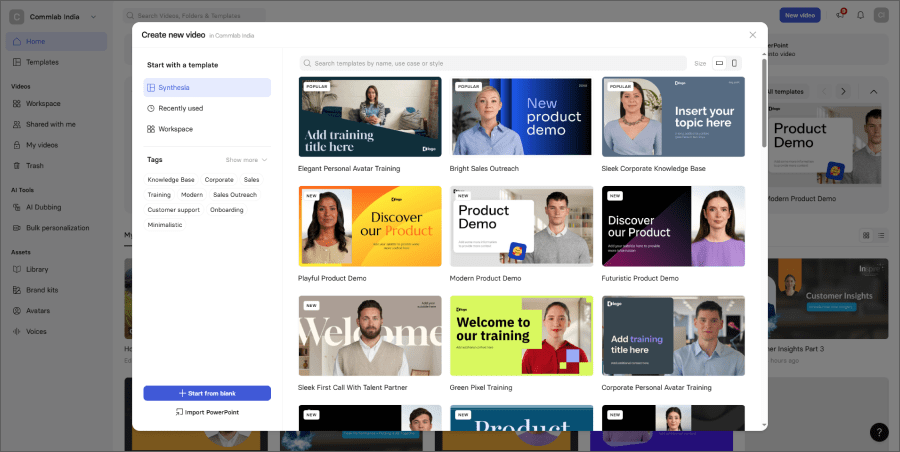
3. Canva (Video Editor)
Canva is a household name for graphic design, but its video editing capabilities have evolved significantly, making it a viable option for simpler training videos. Canva is a highly user-friendly drag-and-drop platform with an extensive library of customizable templates. It’s ideal for enhancing blended learning programs with visual explainers, video quotes, quick guides, or animated presentations that are easy to create and share. It is best for visual aids, event-based learning snippets, learning promotions, and quick, aesthetically pleasing explanatory videos.
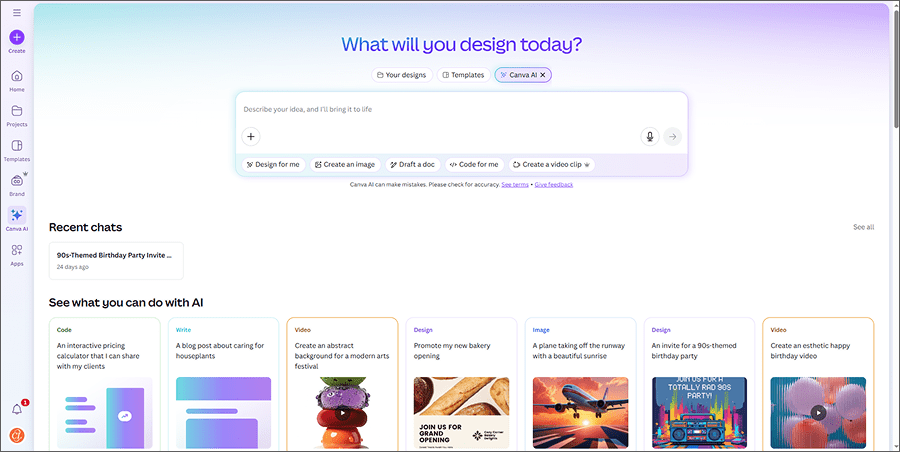
Comparison of Vyond Go, Synthesia and Canva at a Glance
|
Feature |
Vyond Go |
Synthesia |
Canva |
|
Learning Curve |
Low |
Medium |
Low |
|
Video Output |
Animated |
Human-like avatars |
Visual slides + video |
|
AI Voiceover |
Yes |
Yes |
Upload only |
|
Language Options |
70+ languages |
140+ languages & dialects |
Limited |
|
Brand Control |
High |
Moderate (via custom avatars/backgrounds) |
High |
|
SCORM/xAPI Export |
Yes (via Studio) |
Yes (Direct SCORM export) |
No |
|
Accessibility |
Auto-captions |
Subtitles, Multilingual Player |
Manual captions |
|
Best Use Case |
Microlearning |
Localization at scale |
Visual explainers |
Deep Dive into Each Tool’s Strengths & Weaknesses
1. Vyond Go (and Vyond Studio)
Strengths:
- Speed & AI Assistance: Vyond Go is designed for lightning-fast video production. You can go from a text prompt or existing document (DOC, PPT, PDF) to a complete, editable video in seconds. This is a game-changer for urgent training needs or rapid prototyping in L&D.
- Animated & Diverse Styles: Vyond offers a wide range of animated, photorealistic, and mixed-media styles, allowing for highly engaging and visually appealing content. Its diverse character library promotes inclusivity, making content relatable.
Learn how to bring your props to life with this step-by-step Vyond tutorial!
- Character Customization: Beyond pre-built characters, L&D professionals can create custom characters from photos, enhancing brand consistency and making training more personalized.
- Extensive Asset Library: Vyond Studio, which Vyond Go integrates with, provides a massive library of templates, scenes, props, and actions, offering immense creative control for detailed L&D content.
- Ease of Editing & Iteration: While Go generates the initial video, L&D teams can fine-tune every aspect in Vyond Studio, from character actions to script and on-screen text. Updates are remarkably efficient, crucial for evolving training content.
- Localization: Vyond supports translation into over 70 languages, making it excellent for global L&D initiatives and microlearning.
- Microlearning Friendly: The ability to quickly generate short, microlearning videos makes it ideal for bite-sized learning modules and engaging explainers.
- LMS Integration: Offers direct SCORM export via Vyond Studio, ensuring trackability within your Learning Management System.
Weaknesses:
- Learning Curve for Advanced Features: While Go is simple, mastering Vyond Studio’s full range of customization options might take some time for L&D professionals new to animation software.
- Cost: Vyond can be a significant investment, especially for larger teams or enterprise-level features. There are also costs associated with each prompt processed by Vyond’s LLM partners.
- Animation Style Not Always Suitable: While engaging, the animated style might not be appropriate for all types of corporate training, especially those requiring a very serious or highly realistic tone.
- Limited Realism: It does not offer realistic human avatars.
2. Synthesia
Strengths:
- Realistic AI Avatars & Digital Twins: Synthesia boasts a vast library of diverse and expressive AI avatars, offering a human-like presenter without the need for filming. L&D teams can even create personal avatars (digital twins) for a truly branded and consistent presenter experience across all training.
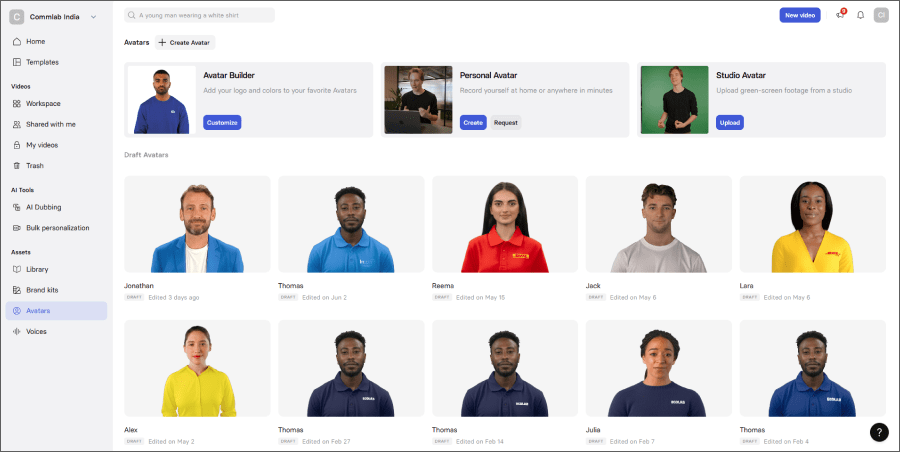
- Unparalleled Multilingual Support & Localization: With support for over 140 languages and dialects, along with automatic lip-syncing and video dubbing, Synthesia is the leader for global L&D initiatives. Their multilingual video player automatically plays content in the viewer’s preferred language, significantly enhancing accessibility and reach.
- Speed & Scalability: Generate professional-looking videos quickly from text. The scalability of avatar-based video production means creating 10 videos isn’t significantly more effort than creating one, ideal for rapid deployment of training.
Discover how Synthesia’s amazing features can help you create professional AI videos quickly and efficiently at scale!
- Consistency & Professional Quality: AI avatars ensure consistent appearance, voice, and delivery across all your content, eliminating inconsistencies that can occur with human presenters and ensuring a high-quality, professional output every time.
- Easy Updates: When policies or information change, L&D professionals simply edit the script, and the avatar video can be regenerated with a click, saving immense time and resources compared to traditional video reshoots.
- Collaboration Features: Offers workspaces and live collaboration, facilitating seamless team-based video creation and feedback within L&D departments.
- Direct SCORM Export: Synthesia allows direct export of videos as SCORM packages, making LMS integration and tracking straightforward for L&D administrators.
- Accessibility: Automated subtitles and multilingual options greatly enhance accessibility for diverse learners.
Weaknesses:
- Cost: Synthesia can be expensive, especially for higher volume usage and enterprise features, which L&D teams in large organizations might need.
- Less Creative Freedom (Visuals): While avatar customization is strong, the visual style is primarily limited to realistic avatars speaking against backgrounds. It lacks the diverse animation styles of Vyond or the broad graphic design capabilities of Canva for more varied visual content.
- “Uncanny Valley” Effect: While AI avatars are highly advanced, some users may still experience the “uncanny valley” effect, where the near-human realism can feel slightly off-putting to some learners.
- Fewer Animation Features: Compared to Vyond, it offers fewer sophisticated animation options for objects and characters beyond the avatar.
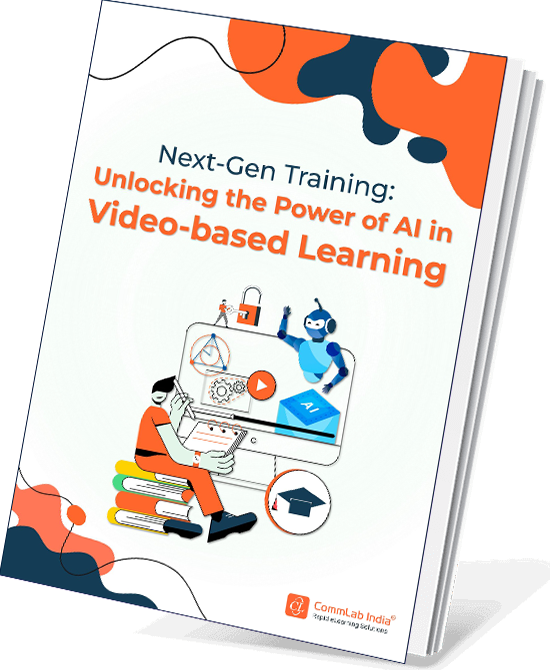
Next-Gen Training: Unlocking the Power of AI in Video-based Learning
Elevate your Training Videos with AI
- Relevance of Video-based Learning
- Various Video Formats
- Potential of AI in Videos
- And More!
3. Canva (Video Editor)
Strengths:
- Extreme Ease of Use & Familiar Interface: Canva’s drag-and-drop interface and intuitive design make it incredibly easy for any L&D professional, regardless of design experience, to create visually appealing content. Its widespread familiarity significantly reduces the learning curve.
- Vast Template & Asset Library: Canva offers a massive collection of video templates, stock footage, images, music, and graphic elements, making it quick to get started and enhance blended learning.
- Affordability: Canva’s pricing, particularly for its Pro and Teams plans, is significantly more budget-friendly than Vyond or Synthesia, making it an accessible option for L&D teams with limited budgets.
- Robust Branding Control: With Canva Pro/Teams, L&D professionals can easily set up brand kits with corporate colors, logos, and fonts to maintain strong brand consistency across all training and communication materials.
- Excellent Collaboration: Canva for Teams allows for seamless collaboration on projects, with shared folders and permission controls, ideal for L&D teams working together on visual assets.
- Versatility: While not specifically a video-first tool, Canva’s strength lies in its ability to combine text, images, and video clips into engaging visual narratives. It’s great for creating animated presentations, infographic-style videos, or quick social media-style training snippets.
Weaknesses:
- Limited Advanced Video Editing: Canva’s video editor is basic compared to dedicated video editing software. It lacks features like multi-track editing, advanced transitions, and fine-grained audio control needed for complex video production.
- No Native AI Avatars or Advanced AI Voice-overs: Canva doesn’t offer native AI avatar generation or highly sophisticated AI voice-overs like Synthesia or Vyond. L&D professionals would need to import these from other tools, and primary narration needs to be uploaded.
- Not Optimized for Full Training Modules: While good for short, visually-driven training or promotional content, it’s less suited for long, complex video lectures or intricate animated scenarios that require tracking within an LMS.
- No Direct SCORM/xAPI Export: Videos created in Canva cannot be directly exported as SCORM or xAPI packages, meaning manual upload to an LMS is typically required, limiting direct tracking capabilities.
- Manual Captions: Accessibility relies on manual captioning rather than automated generation.
If your video content relies heavily on storytelling with customizable characters and scenes, Vyond Go gives you more creative control. For humanized messaging and consistent presenters across different languages, Synthesia’s avatars add a professional and personal touch. Canva works best when paired with static design elements or used to enhance blended learning formats with engaging visual aids. Consider language support, content turnaround time, ease of LMS integration, and the level of localization your training programs require before making your choice.
Integrations, Collaboration & Export Options
|
Tool |
LMS Friendly |
Export Formats |
Collaboration |
|
Vyond Go |
Yes (via Studio – SCORM) |
MP4, SCORM |
Yes |
|
Synthesia |
Yes (Direct SCORM export) |
MP4 + Subtitles, SCORM |
Yes |
|
Canva |
No (manual upload) |
MP4, GIF |
Yes |
Final Recommendation: What Works Best for Your Team?
The “best” tool ultimately depends on your organization’s specific training philosophy, budget, and desired video style.
Choose Vyond Go if your L&D team needs
- Fast-paced microlearning and animated explainers.
- Easy authoring with rich animated storytelling and diverse character options.
- LMS-ready formats and strong brand control within an animated context.
Choose Synthesia if your L&D team needs
- Realistic presenter-led videos for soft skills, onboarding, and leadership messages.
- Extensive language localization at scale for global audiences.
- Consistency in delivery across regions and the ability to update content easily with AI avatars.
Choose Canva if your L&D team is
- Working with tight budgets and short timelines for visual assets.
- Creating quick support videos, visual training aids, or marketing-aligned learning content.
- Enhancing learning communication or blended programs with engaging graphic-driven video.
Key Takeaway for L&D Teams
Choosing the right tool can mean faster creation, better learner engagement, and fewer design bottlenecks. It’s about aligning video production tools with long-term training goals — scalability, consistency, and ROI.
Ultimately, a hybrid approach often works best. Many organizations find success by using Vyond Go for animation-rich explainers, Synthesia for leadership messages and global onboarding programs, and Canva for visual supplements and quick learning promotions — all tied into their LMS or LXP for seamless delivery. By understanding the unique strengths of each tool, your L&D team can create training videos that truly resonates and drives learning outcomes.
Unlock the full potential of video-based learning with our comprehensive eBook! Discover how AI can elevate your training videos and optimize learning outcomes, explore proven strategies to design and implement video-based learning for maximum ROI, and stay ahead with insights into emerging trends shaping the future of corporate training.
View the original article and our Inspiration here


